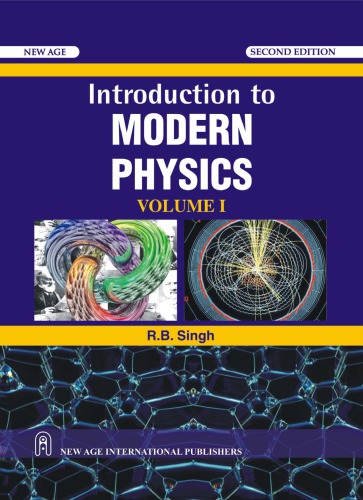

Most ebook files are in PDF format, so you can easily read them using various software such as Foxit Reader or directly on the Google Chrome browser.
Some ebook files are released by publishers in other formats such as .awz, .mobi, .epub, .fb2, etc. You may need to install specific software to read these formats on mobile/PC, such as Calibre.
Please read the tutorial at this link. https://ebooknice.com/page/post?id=faq
We offer FREE conversion to the popular formats you request; however, this may take some time. Therefore, right after payment, please email us, and we will try to provide the service as quickly as possible.
For some exceptional file formats or broken links (if any), please refrain from opening any disputes. Instead, email us first, and we will try to assist within a maximum of 6 hours.
EbookNice Team

Status:
Available0.0
0 reviews
ISBN 10: 812242922X
ISBN 13: 9788122429220
Author: R B Singh
"Introduction to Modern Physics" is a foundational course and textbook topic in physics, covering the revolutionary developments of the 20th century, primarily quantum mechanics and relativity, and their applications. Different textbooks will structure the material somewhat differently, but the core topics remain consistent.
Part 1: Relativity and Quantum Mechanics: The Foundations of Modern Physics
Chapter 1: Relativity I
The Experimental Basis of Relativity
Michelson-Morley Experiment
Einstein's Postulates
The Lorentz Transformation
Calibrating the Spacetime Axes
Time Dilation and Length Contraction
The Doppler Effect
Transverse Doppler Effect
The Twin Paradox and Other Surprises
The Case of the Identically Accelerated Twins
Superluminal Speeds
Chapter 2: Relativity II
Relativistic Momentum
Relativistic Energy
From Mechanics, Another Surprise
Mass/Energy Conversion and Binding Energy
Invariant Mass
General Relativity
Deflection of Light in a Gravitational Field
Gravitational Redshift
Perihelion of Mercury's Orbit
Delay of Light in a Gravitational Field
Chapter 3: Quantization of Charge, Light, and Energy
Quantization of Electric Charge
Blackbody Radiation
The Photoelectric Effect
X Rays and the Compton Effect
Derivation of Compton's Equation
Chapter 4: The Nuclear Atom
Atomic Spectra
Rutherford's Nuclear Model
Rutherford's Prediction and Geiger and Marsden's Results
The Bohr Model of the Hydrogen Atom
Giant Atoms
X-Ray Spectra
The Franck-Hertz Experiment
A Critique of Bohr Theory and the "Old Quantum Mechanics"
Chapter 5: The Wavelike Properties of Particles
The de Broglie Hypothesis
Measurements of Particle Wavelengths
Wave Packets
The Probabilistic Interpretation of the Wave Function
The Uncertainty Principle
The Gamma-Ray Microscope
Some Consequences of the Uncertainty Principle
Wave-Particle Duality
Chapter 6: The Schrödinger Equation
Schrödinger's Trick
Parity
Reflection and Transmission of Waves
Alpha Decay
NH3 Atomic Clock
Tunnel Diode
Chapter 7: Atomic Physics
The Schrödinger Equation in Three Dimensions
Quantization of Angular Momentum and Energy in the Hydrogen Atom
The Hydrogen Atom Wave Functions
Electron Spin
Stern-Gerlach Experiment
Total Angular Momentum and the Spin-Orbit Effect
The Schrödinger Equation for Two (or More) Particles
Ground States of Atoms: The Periodic Table
Excited States and Spectra of Atoms
Chapter 8: Statistical Mechanics
The Photon Gas: An Application of Bose-Einstein Statistics
Properties of a Fermion Gas
Part 2: Applications of Quantum Mechanics and Relativity
Chapter 9: Molecular Structure and Spectra
The Ionic Bond
The Covalent Bond
Other Covalent Bonds
Other Bonding Mechanisms
Energy Levels and Spectra of Diatomic Molecules
Scattering, Absorption, and Stimulated Emission
Lasers and Masers
Chapter 10: Solid State Physics
The Structure of Solids
Classical Theory of Conduction
Free-Electron Gas in Metals
Quantum Theory of Conduction
Thermal Conduction—The Quantum Model
Magnetism in Solids
Spintronics
Band Theory of Solids
Energy Bands in Solids—An Alternate Approach
Impurity Semiconductors
Hall Effect
Semiconductor Junctions and Devices
How Transistors Work
Superconductivity
Chapter 11: Nuclear Physics
Energetics of Alpha Decay
The Mössbauer Effect
The Nuclear Force
Probability Density of the Exchange Mesons
The Shell Model
Finding the “Correct” Shell Model
Nuclear Reactions
Fission and Fusion
Nuclear Power
Interaction of Particles and Matter
Chapter 12: Particle Physics (Details not explicitly provided in snippets but typically covered in modern physics texts)
Chapter 13: Cosmology and Astrophysics (Details not explicitly provided in snippets but typically covered in modern physics texts)
Is There Life Elsewhere?
The Stars
The Celestial Sphere
The Evolution of Stars
Cataclysmic Events
Final States of Stars
Galaxies
Cosmology and Gravitation
Cosmology and the Evolution of the Universe
“Natural” Planck Units
introduction to modern physics
introduction to modern physics theoretical foundations pdf
introductory modern physics
introduction to physics in modern medicine
physics introduction pdf
Tags: R B Singh, modern, physics